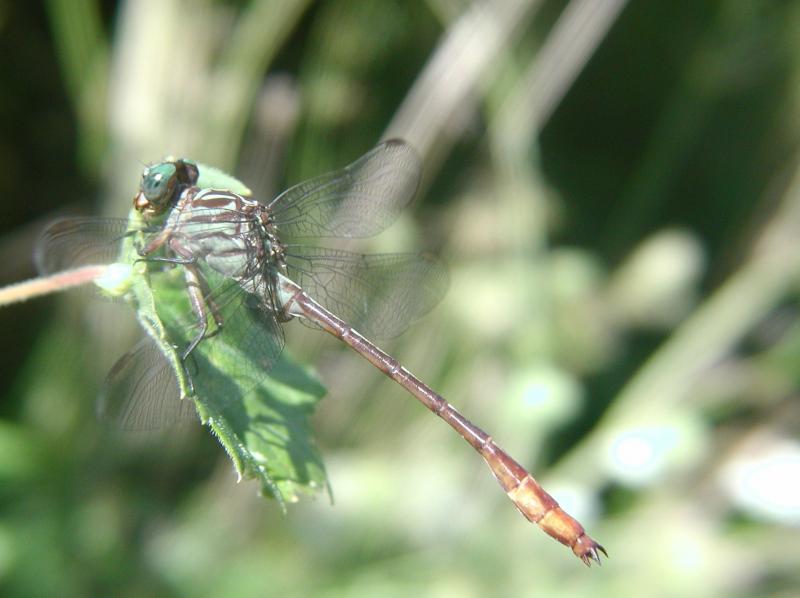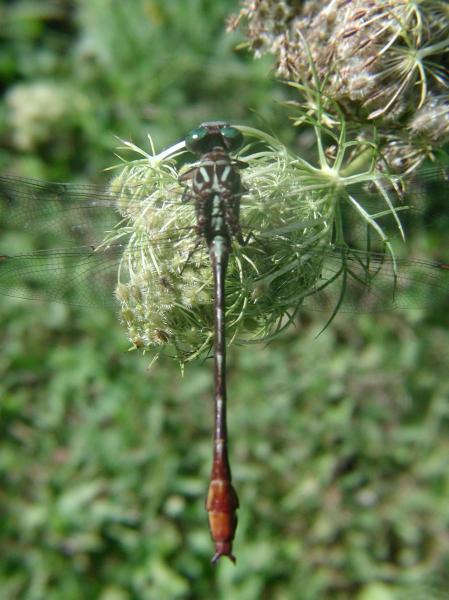Russet-tipped Clubtail
Stylurus plagiatus (Selys, 1854)
- Class
- Insecta (Insects)
- Family
- Gomphidae (Clubtails)
- State Protection
- Not Listed
Not listed or protected by New York State.
- Federal Protection
- Not Listed
- State Conservation Status Rank
- S1
Critically Imperiled in New York - Especially vulnerable to disappearing from New York due to extreme rarity or other factors; typically 5 or fewer populations or locations in New York, very few individuals, very restricted range, very few remaining acres (or miles of stream), and/or very steep declines.
- Global Conservation Status Rank
- G5
Secure globally - Common in the world; widespread and abundant (but may be rare in some parts of its range).
Summary
Did you know?
Dragonflies in the Clubtail family of the genus Stylurus are known as the Hanging Clubtails. They get their name from their perching behavior. When they perch on leaves in trees, their weight can bend the leaves downward until they are "hanging" almost vertically (Dunkle 2000, Mead 2003).
State Ranking Justification
The Russet-tipped Clubtail is known to occur in seven counties in New York State, with no population estimates determined. Further survey efforts may result in the identification of additional populations, range expansions, or enable population sizes to be estimated.
Short-term Trends
No estimate of population size for the Russet-tipped Clubtail has been made based on observations made in the early and mid-1990s (New York Natural Heritage Program 2007). Information prior to this time frame is limited. Therefore, any new location information on the Russet-tipped Clubtail in New York may reflect heightened interest in surveying for this species rather than a population increase or a range expansion (Holst 2005).
Long-term Trends
Recent observations of Russet-tipped Clubtails have been made in Columbia and Dutchess counties, New York in the early 1990s. General reports of observations made also include locations in Albany, Greene, Putnam, Rockland, and Warren counties, as well as on Long Island (Gebauer et al. 2005, Donnelly 2004). Since these are fairly recent records, and the full extent and size of the populations have not been determined, long-term trends are unclear.
Conservation and Management
Threats
Any activity which might lead to water contamination or the alteration of natural hydrology could impact Russet-tipped Clubtail populations (Holst 2005).
Conservation Strategies and Management Practices
Any efforts to reduce water contamination, hydrological alteration, and surrounding upland development of rivers, streams, and large lakes should be considered when managing for this species (Holst 2005).
Research Needs
Further research is needed to define the distribution and population size of the Russet-tipped Clubtail. In addition, research is required to understand the habitat requirements and threats to this species, and to create appropriate management guidelines for its persistence in known locations (Holst 2005).
Habitat
Habitat
The Russet-tipped Clubtail inhabits rivers, streams, and large lakes with sandy substrate (Walker 1958, Dunkle 2000). Larvae are aquatic and found in the water during this lifestage, whereas adults are terrestrial and are found in habitats surrounding streams, rivers and lakes.
Associated Ecological Communities
- Freshwater intertidal mudflats
(guide)
A sparsely vegetated community characterized by low rosette-leaved aquatics. This community occurs on exposed intertidal mudflats where the water is fresh (salinity less than 0.5 ppt). This community is best developed where mudflats are nearly level so that broad expanses are exposed at low tide. The plants are completely submerged in 0.9 to 1.2 m (3 to 4 ft) of water at high tide and they are usually coated with mud.
- Tidal river
(guide)
The aquatic community of a river under the influence of daily lunar tides. We restrict this community to the continuously flooded portions of the river where plants do not grow out of the water. A deepwater zone has depths averaging more than 2 m (6 ft) at low tide. Salinities at any one place in the river may fluctuate as the tides flow in and out.
Range
New York State Distribution
The Russet-tipped Clubtail is confirmed in locations from seven counties in the eastern portion of the state, as well as Long Island (Donnelly 2004, Gebauer et al. 2005, New York Natural Heritage Program 2007).
Global Distribution
The Russet-tipped Clubtail is distributed across North America from Ontario and the northeastern United States south to Florida, then west to the midwest as far as South Dakota south to Texas. It is also known to occur in New Mexico, Arizona, California, and Nuevo Leon and Sonora, Mexico (Dunkle 2000, Abbott 2007).
Best Places to See
- Hudson River
Identification Comments
Identifying Characteristics
As their name suggests, Clubtails have an enlarged tip on the end of their abdomens, giving them a club-like appearance. Clubtails in the genus Stylurus have long and slender abdomens with small to moderately sized clubs. The eastern form of the Russet-tipped Clubtail has a gray-green thorax with dark lateral (side) stripes. This form also has a rusty orange "club" (on abdominal segments 7-10). They are 2.4 inches in length with green eyes and, as with all Gomphids, their eyes are separated dorsally (from the top-down view). Their abdomens are brown with a median green stripe. Male terminal appendages and female subgenital plates are distinctive from other Stylurus species when examined under magnification. Female Russet-tipped Clubtails are more drab, have a more elongate abdomen, and a much narrower club than males. Both sexes have a brownish face and short, blackish brown legs.
Behavior
Gomphid larvae spend much of their time burrowing into the substrate of rivers and lakes were they are found. Adult Stylurus prefer perching spots on leaf surfaces in trees high off the ground (Nikula et al. 2003). They maintain prolonged flights over water to forage and fly to treetops to consume their meal (Walker 1958). Adult males patrol from 9 A.M. to dark and are strong fliers (Dunkle 2000).
Diet
Russet-tipped Clubtail larvae feed on smaller aquatic invertebrates and adults feed on insects which they capture in flight, frequently diving into the water to retrieve a prey item (Walker 1958).
Best Time to See
Stylurus plagiatus are active from late June into late September in a northern climate (Dunkle 2000). Clubtails in the genus Stylurus are most abundant in August and early September (Nikula et al. 2003). Adult males may be found patrolling their territories from 9 in the morning until dark (Dunkle 2000). Larvae may be found in appropriate habitats year-round.
- Present
- Reproducing
The time of year you would expect to find Russet-tipped Clubtail present and reproducing in New York.
Similar Species
- Riverine Clubtail (Stylurus amnicola)
The thorax of the Riverine Clubtail is dark brown with a yellowish green T-shaped collar. Its abdomen is black with yellow markings. This species is smaller and has a paler thorax than the Arrow Clubtail (Nikula et al. 2003).
- Elusive Clubtail (Stylurus notatus)
The abdominal segements 7-9 of the Elusive Clubtail have areas of dark brown and yellow, as opposed to the orange-brown coloration of these segments on the Russet-tipped Clubtail (Needham et al. 2000).
- Zebra Clubtail (Stylurus scudderi)
The Zebra Clubtail is a similarly large clubtail to the Russet-tipped, but the Zebra is the only large clubtail with greenish yellow rings on segments 3-7 of a black abdomen (Dunkle 2000, Nikula et al. 2003).
- Arrow Clubtail (Stylurus spiniceps)
Arrow Clubtails have a very elongate appearance with a slender club (Nikula et al. 2003). This is the only Stylurus with abdominal segment 9 noticably longer than segment 8 (Dunkle 2000).
Russet-tipped Clubtail Images
Taxonomy
Russet-tipped Clubtail
Stylurus plagiatus (Selys, 1854)
- Kingdom Animalia
- Phylum Arthropoda
(Mandibulates)
- Class Insecta
(Insects)
- Order Odonata
(Dragonflies and Damselflies)
- Family Gomphidae (Clubtails)
- Order Odonata
(Dragonflies and Damselflies)
- Class Insecta
(Insects)
- Phylum Arthropoda
(Mandibulates)
Additional Resources
References
Abbott, J.C. 2007. OdonataCentral: An online resource for the odonata of North America. Austin, Texas. Available at http://odonatacentral.com (accessed February 28, 2007).
Donnelly, T. W. 1992. The odonata of New York State. Bulletin of American Odonatology. 1(1):1-27.
Donnelly, T.W. 1999. The dragonflies and damselflies of New York. Prepared for the 1999 International Congress of Odonatology and First Symposium of the Worldwide Dragonfly Association. July 11-16, 1999. Colgate University, Hamilton, New York. 39 pp.
Donnelly, T.W. 2004. The Odonata of New York State. Unpublished data. Binghamton, NY.
Dunkle, S.W. 2000. Dragonflies through binoculars: A field guide to dragonflies of North America. Oxford University Press: 266 pp.
Mead, K. 2003. Dragonflies of the North Woods. Kollath-Stensaas Publishing, Duluth, MN. 2003 pp.
NatureServe. 2007. NatureServe Explorer: An online encyclopedia of life [web application]. Version 6.1. NatureServe, Arlington, Virginia. Available http://www.natureserve.org/explorer. (Accessed: January 11, 2007).
Needham, J.G., M.J. Westfall, Jr., and M.L. May. 2000. Dragonflies of North America. Revised edition. Scientific Publishers, Gainesville, Florida. 939 pp.
New York Natural Heritage Program. 2007. Biotics Database. Albany, NY.
New York Natural Heritage Program. 2024. New York Natural Heritage Program Databases. Albany, NY.
New York Natural Heritage Program. No date. New York dragonfly and damselfly survey database. New York State Department of Environmental Conservation. Albany, NY.
New York State Department of Environmental Conservation. 2005. Comprehensive Wildlife Conservation Strategy Planning Database. New York State Department of Environmental Conservation. Albany, NY.
Nikula, B., J.L. Loose, and M.R. Burne. 2003. A field guide to the dragonflies and damselflies of Massachusetts. Division of Fisheries and Wildlife, Natural Heritage and Endangered Species Program, Westborough, MA. 197 pp.
Walker, E.M. 1958. The odonata of Canada and Alaska. Vol 2. The Anisoptera-four families. Univ. Toronto Press 318 pp.
Links
About This Guide
Information for this guide was last updated on: April 5, 2007
Please cite this page as:
New York Natural Heritage Program. 2024.
Online Conservation Guide for
Stylurus plagiatus.
Available from: https://guides.nynhp.org/russet-tipped-clubtail/.
Accessed July 27, 2024.

